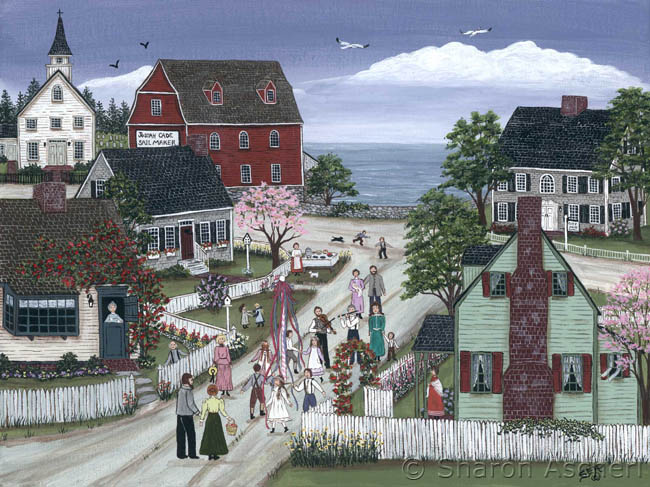Father's Day 2010
With a special tribute to the octogenarian fathers of the world . . .
Labels: Special occasion

Labels: Special occasion
Labels: Arts, Special occasion

Labels: Arts, Special occasion

Labels: Special occasion

Labels: Arts
Labels: Cooking and food, Special occasion

The Smiths are from Florida originally, of Irish and British extraction, but the Cajuns have accepted them as their own. Latham is something of a legend in the towing world. When he and [first wife] Elsbeth first took to the sea, in the late sixties, they seemed like characters from a picture book: the little tugboat family, island-hopping across the Caribbean, homeschooling five children as they went. Together and separately, Latham and his children have weathered cyclones on the Atlantic, towed barges up the Amazon, and circumnavigated the globe, even as the industry around them has grown ever more regulated and safety-conscious.If this story of one family's life in the the tugboating world appeals to you, by all means get yourself a copy of the April 19 New Yorker and read the whole thing. The entire issue is dedicated to the theme of travel, so if that's your cup of tea, you'll find other articles of interest as well. The table of contents is here.
. . .
"When we started out, you could do anything," Elsbeth says. "You could pick up your crew from the homeless section of the DuPont Plaza parking lot and take 'em out and sober 'em up." ... "The other tugboats, they always went for the old alkies and the deadbeat people," Elsbeth says. "We took a different approach," ... Latham took to hiring any sailor or surfer who wandered past and whose conversation he could half abide. "It was the time of the flower children, the Beatles, and the long skirts," Elsbeth says. "We found people everywhere, just everywhere — beautiful young people. These hippies would come down on a one-way ticket from Florida to Rincón, Puerto Rico, and they'd run out of money and get desperate. So we'd hire them just for the ride back to the States." ...
When regulations began to tighten, in the seventies, and a minimum of two licensed sailors were required on every tug, Latham and Elsbeth both put in for captain's licenses.
. . .
... the footloose spirit that once sent sailors to sea has been slowly starched out of the business — mostly with good reason. Beginning with the Exxon Valdez oil spill, in 1989, regulations have ratcheted up with each high-profile accident ...
Most tug captain's licenses now require at least three years' training at sea, if not a four-year degree from a maritime academy. Background checks, safety inspections, and drug and alcohol tests are mandatory, as are certifications in radar, firefighting, first aid, and social responsibility. As a result, in the past decade oil spills have decreased by more than eighty per cent compared with the nineteen-nineties, and crew fatalities and injuries have been nearly cut in half.
... the tramping days of Latham's youth, when a sailor could spend his shore leave exploring the markets of Bangkok, the bars of Panama City, are gone.
. . .
Technology has taken some of the risk out of the business. Many new tugs can be steered by joystick — though most captains disdain it — and trainees often learn to operate them on land, in mock wheelhouses surrounded by virtual harbors. (When I tried my hand at this recently at the Maritime Simulation Institute, in Middletown, Rhode Island, I spent an hour doing doughnuts in Los Angeles Harbor; I couldn't seem to stop ramming my bow into the container ship I was towing — and that was before the computer called in the heavy fog and twenty-foot seas.) But a virtual storm is still no substitute for a howling gale, or the mad tilt and groaning steel of a ship on rough seas.
Labels: Competencies, Expertise, Hiring and getting hired, Humor, Simulation, Teaching
ER nurses log in to the virtual world, where each assumes control of an avatar — a cartoon rendering of a nurse wearing crisp blue scrubs. The nurses can walk their avatars through hallways, up and down stairs and through doorways using keyboard or mouse controls. They can give voice to their avatars by typing — their words pop up as a text box — or by speaking into a special microphone. Headsets let each nurse hear ambient noise from the virtual scene and listen to the other avatars talking.The above gives you an idea of how a Second Life medical simulation can be set up. You can check out the look and feel of one such simulation in the video below, which is an overview of Second Life training prepared for paramedic students at St. George's University of London.
In the drill, which lasts three hours, the nurse-avatars must create a triage system, assess each patient and figure out how to isolate the most contagious.
Some patient avatars are controlled by instructors ... Other avatars are preprogrammed; they speak only phrases that the instructors have prerecorded ("I can't breathe!"). Nurse-avatars can click on the patients' bodies to pull up text boxes with vital signs and a list of symptoms.
At any point, the instructor can "throw a wrench into the system," Dr. Greci [the simulation's developer] says, by setting off a virtual earthquake or blackout or dumping rain on the patients waiting outside.
Labels: Simulation
Labels: Arts